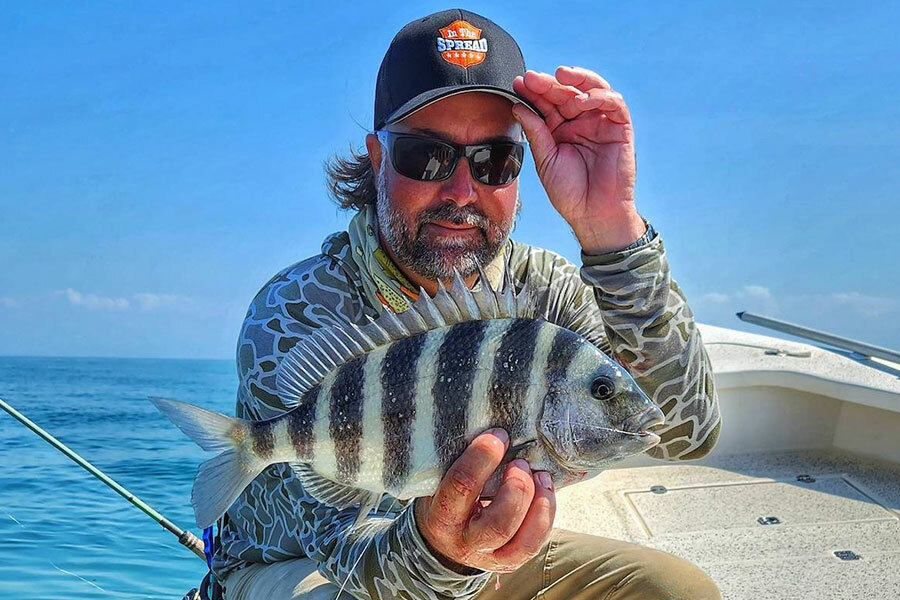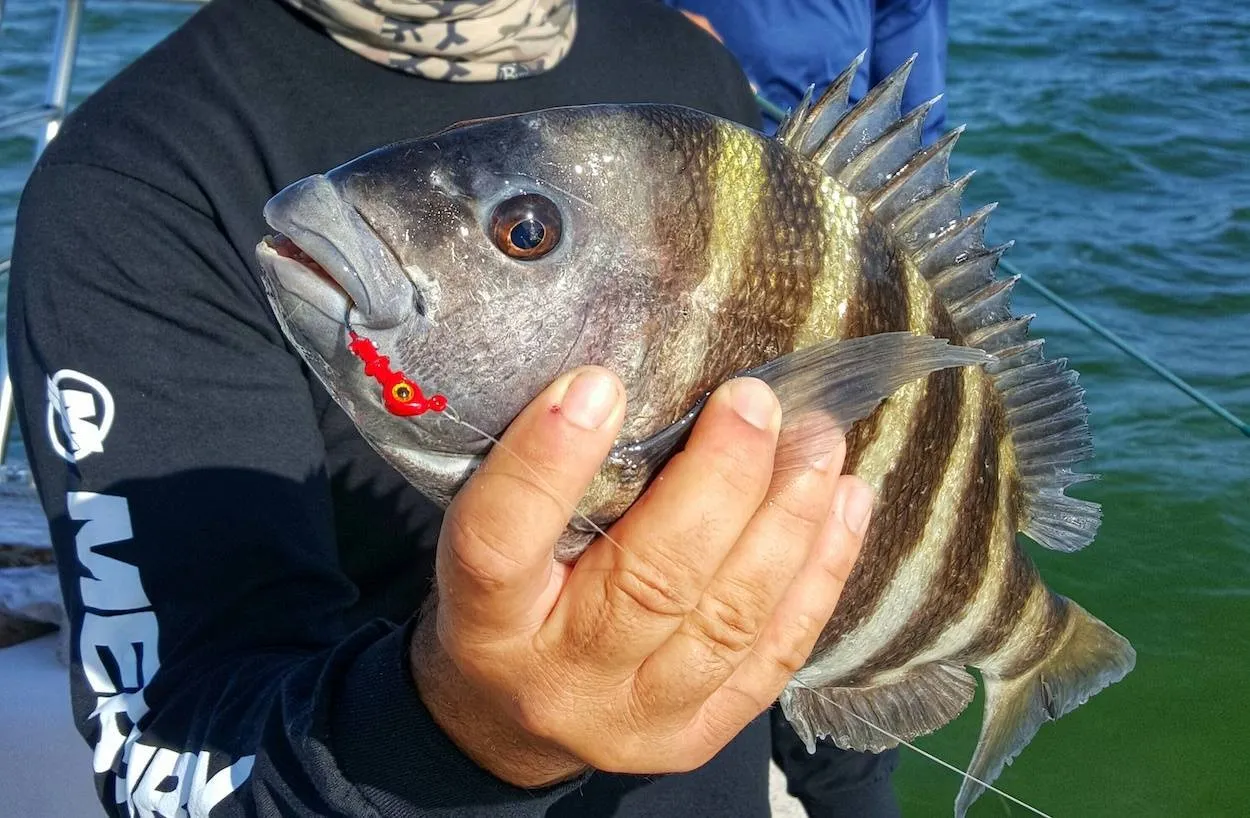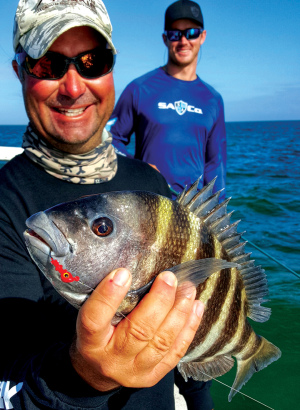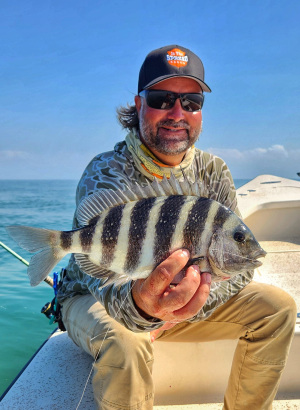Sheepshead, a challenging fish with black and white stripes, are found near docks, reefs, jetties, wrecks, and inlets. They are daytime feeders and can be spooked easily. They prefer structures and prefer rigs like the Sheepshead Jig and Bottom Rig. Techniques include matching local food sources, fishing during peak tidal flow, and using live bait. They are prized targets along the Gulf Coast and Southeastern seaboard.

Catching Sheepshead - A Thrilling Pursuit in Saltwater Fishing
Summary:
- What are Sheepshead? A challenging catch with signature black and white stripes. Members of the porgy family, these fish are known for their sharp teeth and finicky feeding habits.
- Habitats: Preferring structures, sheepshead can be found near docks, reefs, jetties, wrecks, and inlets.
- Feeding Behaviors: Daytime feeders, they are subtle biters and can be spooked easily.
- Rigging & Baits: Techniques include the Sheepshead Jig and Bottom Rig, with preferred baits like fiddler crabs, sand fleas, and shrimp.
- Advanced Techniques: Matching local food sources, fishing during peak tidal flow, and using live bait can increase success rates.
- Best Locations: Prime spots across the Southeast include Mosquito Lagoon, Tampa Bay, Matanzas Inlet, and Charleston Harbor, among others.
- Essential Tackle: Gear up with sensitive rods, durable reels, braided lines, and the right terminal tackle for a successful sheepshead fishing experience.
The Ultimate Guide to Catching Sheepshead: Tips, Techniques, and Hotspots
For seasoned saltwater anglers, few pursuits provide as much excitement and reward as landing a big sheepshead. With their signature black and white striped bodies, sharp teeth, and finicky feeding habits, sheepshead present a worthy challenge for even the most seasoned fishermen. Their elusive nature and fighting spirit when hooked make them a prized target species along the Gulf Coast and Southeastern seaboard.
In this comprehensive guide, we'll explore everything you need to know to be successful in your quest for these striped sea predators. From understanding their habits and habitat to mastering proven rigging techniques, you'll gain the knowledge to elevate your sheepshead fishing skills. So grab your rods and get ready for an epic battle against one of the slipperiest adversaries of the briny deep.
An Introduction to the Wily Sheepshead
Before we dive into the strategies and gear for targeting sheepshead, it helps to understand a bit more about these unique fish. Members of the porgy family, sheepshead (Archosargus probatocephalus) are named for their oversized front teeth and sheeplike appearance. They inhabit coastal waters, bridges, reefs, and wrecks throughout the Southeastern United States and Gulf of Mexico.
While sheepshead coloring can vary from silver to black, their most distinguishing feature is the series of five to seven dark, vertical stripes along the length of their bodies. Other identifiable characteristics include a deep, flattened body shape, sharp dorsal spines, and an undershot jaw with protruding front teeth.
Sheepshead feed primarily on crabs, shrimp, and bivalves like oysters, crushing their prey with their massive jaws and strong teeth. Their diet gives their flesh a sweet, succulent taste that is highly prized by seafood lovers. Given their elusive feeding habits, they present a worthy adversary that will test even seasoned anglers.
Understanding when and where to find sheepshead is the first step in a successful pursuit. Read on for tips on their ideal habitats, feeding behaviors, and other tricks for locating and hooking these cagey fish.

Prime Sheepshead Habitats - Where to Find Your Striped Adversary
One of the keys to sheepshead fishing success is identifying their preferred habitats. Unlike other schooling species, sheepshead are most often found alone or in small groups. Look for structures that attract the crustaceans and shellfish they prey on. This includes:
- Docks and Pilings: Sheepshead are structure oriented bottom feeders. Any kind of piling or dock structure will attract them by providing habitat for crabs and other prey. Target pilings covered in barnacles or oysters.
- Nearshore Reefs: Rocky outcroppings and coral reefs hold an abundance of sheepshead food sources. Focus on transitional zones between sandy and rocky bottoms.
- Jetties and Breakwalls: Rock jetties are like magnets for sheepshead searching for food. Target areas with strong current flows.
- Wrecks and Artificial Reefs: Submerged wrecks or artificial reefs act as oases that draw in all forms of marine life, including sheepshead.
- Inlets and Passes: Areas where tidal flow is concentrated attract all kinds of baitfish, making them prime feeding zones for sheepshead. Target eddies and structure.
No matter your fishing location, look for current breaks, structure, and the presence of barnacles or oysters. These are the telltale signs of sheepshead habitat.
Mastering Sheepshead Feeding Behaviors
In addition to location, you need to understand sheepshead feeding patterns and behaviors to improve your catch. Here are some of their unique tendencies to factor into your fishing strategy:
- Subtle Biters: Sheepshead are known for tentatively nibbling at bait before swallowing hooks. Use ultra-sensitive gear to detect bites.
- Wary Nature: Easily spooked, sheepshead will drop a bait at the slightest resistance or unnatural movement. Use natural baits and light lines.
- Daytime Feeders: Sheepshead feed most actively in daylight hours near structures. Low light and night fishing is less productive.
- Weather Factors: Try fishing on overcast days or before cold fronts when feeding activity increases.
- Patience: Perhaps the most important tip - don't rush! Sheepshead fishing requires persistence and Zen-like patience. Stay focused.
Now that you know where to find sheepshead and their feeding behaviors, let's look at proven rigging methods to entice them to bite.
Rigging for Success - The Best Sheepshead Rigs & Baits
Choosing the right bait and rig is critical when pursuing finicky sheepshead. You need gear sensitive enough to detect subtle bites yet strong enough to wrestle them from their rocky lairs. Here are two proven rigging methods to consider:
The Sheepshead Jig
Jigs allow exceptional feel for detecting bites combined with vertical control of your bait. Follow this setup:
- Jighead: 1/4 to 1 ounce lead jighead with ultra sharp hooks
- Line: 15-20 lb. braided line for sensitivity
- Rod: Medium action 7 ft. rod combined with a 2500-3000 series reel
- Baits: Live shrimp, fiddler crabs, sand fleas threaded onto jig hook
- Technique: Make short, rod lifts interspersed by pauses to impart action. Detect bites during pauses as jig drops
The Sheepshead Bottom Rig
This simple rig anchors your bait to the bottom with maximum bite sensitivity:
- Hook: Small fine wire live bait hook, like a #1 octopus circle hook
- Weight: Just enough split shot or egg sinker to keep bait down
- Line: 10-15 lb. mono or fluorocarbon for low visibility
- Rod: 7-8 ft. medium action rod with a 2500-3000 series reel
- Baits: Fiddler crabs, sand fleas, oysters, shrimp on bottom
- Technique: Let rig sit on bottom lifitng rod slowly to feel for bites. Use circle hook to prevent gut hook sets.
Both these proven rigging methods will up your odds of catching sheepshead. Now let's look at the best bait options.
Top Sheepshead Baits
While sheepshead eat a variety of crustaceans and shellfish, three baits rise above when targeting them:
- Fiddler Crabs: Fiddlers perfectly match the natural sheepshead diet. Hook through the shell or use a corkscrew for livelier action.
- Sand Fleas: Pinch the shell on sand fleas to keep them lively. Thread onto a hook or jighead.
- Shrimp: Small live shrimp or fresh dead shrimp make excellent bait. Hook through the tail for natural movement.
Tip: Add a attractant spray like Pro-Cure to your baits give them an edge over natural food sources.
Advanced Tactics and Techniques
You've got the right gear. You understand their feeding habits. Now let's look at some next level sheepshead fishing tactics to take your success to the next level:
- Match the Hatch: Pay attention to local food sources and match your bait accordingly. For example, if oysters are prevalent, tip your jig with a shucked oyster. Doing this literally puts the food they are feeding on right in front of them for easy eating.
- Fish the Tides: Plan your fishing trips around peak tidal flow periods. Sheepshead feed most actively when currents are ripping past structures. Target turn of tides for best action.
- Use Live Bait: The movement of a live fiddler crab or shrimp is far more enticing than any artificial lure. Take the time to collect fresh live bait before fishing. Your catches will reflect the extra effort.
- Watch Your Line: Sheepshead nibbles are barely perceptible on even the most sensitive gear. Keep a finger on the line or tie a small bell above your rig to see subtle bites.
- Vary Depths: Don't stick to one depth. Sheepshead feed at different levels depending on tide stages and activity. Vary bait depths between the surface, midway, and bottom structure to find where they are feeding.
With these advanced tips, you now have the knowledge to take your sheepshead fishing expertise to the next level.
Top Sheepshead Fishing Locations Across the Southeast
Now that you're armed with expert techniques for finding and catching sheepshead, where are the hottest spots to test your skills? Here are some of the region's most productive fisheries to plan your next sheepshead trip:
- Mosquito Lagoon, Florida - Miles of shallow flats, oyster beds, and mangroves near Oak Hill, Florida.
- Tampa Bay, Florida - Massive bay system with abundant structure, reefs, and diverse habitat to hold sheepshead.
- Matanzas Inlet, Florida - Strong tidal flow around bridge pilings and rock jetties of this St. Augustine inlet.
- Charleston Harbor, South Carolina - Historic harbor with extensive jetties, reefs, and shipwrecks holding sheepshead.
- Mobile Bay, Alabama - Huge bay dotted with piers, pilings, and underwater structure that sheepshead gravitate to.
- Chandeleur Islands, Louisiana - Remote barrier island chain with pristine habitat and spectacular fishing for big sheepshead.
- Aransas Pass, Texas - Rock jetties at this Texas pass attract sheepshead migrating along the Gulf Coast.
A great approach is to start researching fishing reports and forums specific to your target areas. This will provide insights on current conditions and the best times to plan your sheepshead fishing trips.
Gearing Up for Success - Must Have Sheepshead Tackle
Having the right tackle and gear makes a huge difference when tangling with hard fighting, structure oriented sheepshead. Here are some fishing essentials to include in your arsenal:
- Sensitive Rods - A 7-8 foot medium action rod that easily loads up helps detect subtle bites.
- Reels - Pick a 3000-5000 series spinning reel with smooth drag and high line capacity for long battles.
- Lines - Strong braided lines like Power Pro resist abrasion yet still transmit bites.
- Terminal Tackle - Carry an assortment of jig heads, live bait hooks, and sinker weights.
- Nets - Sturdy nets with longer handles help control fish around structure.
- Pliers - Long nose pliers safely remove hooks from toothy sheepshead mouths.
- Cooler - A quality cooler keeps your catch fresh until ready to cook up a tasty sheepshead feast!
With the information presented in this guide, you now have the knowledge to challenge one of the saltwater's most elusive gamefish. Master the techniques discussed here and you'll be sure to experience the rush that only tangling with a brute sheepshead can provide. Tight lines and remember to savor the reward when you finally conquer these striped adversaries!
Captain William Toney In The Spread, Instructor












